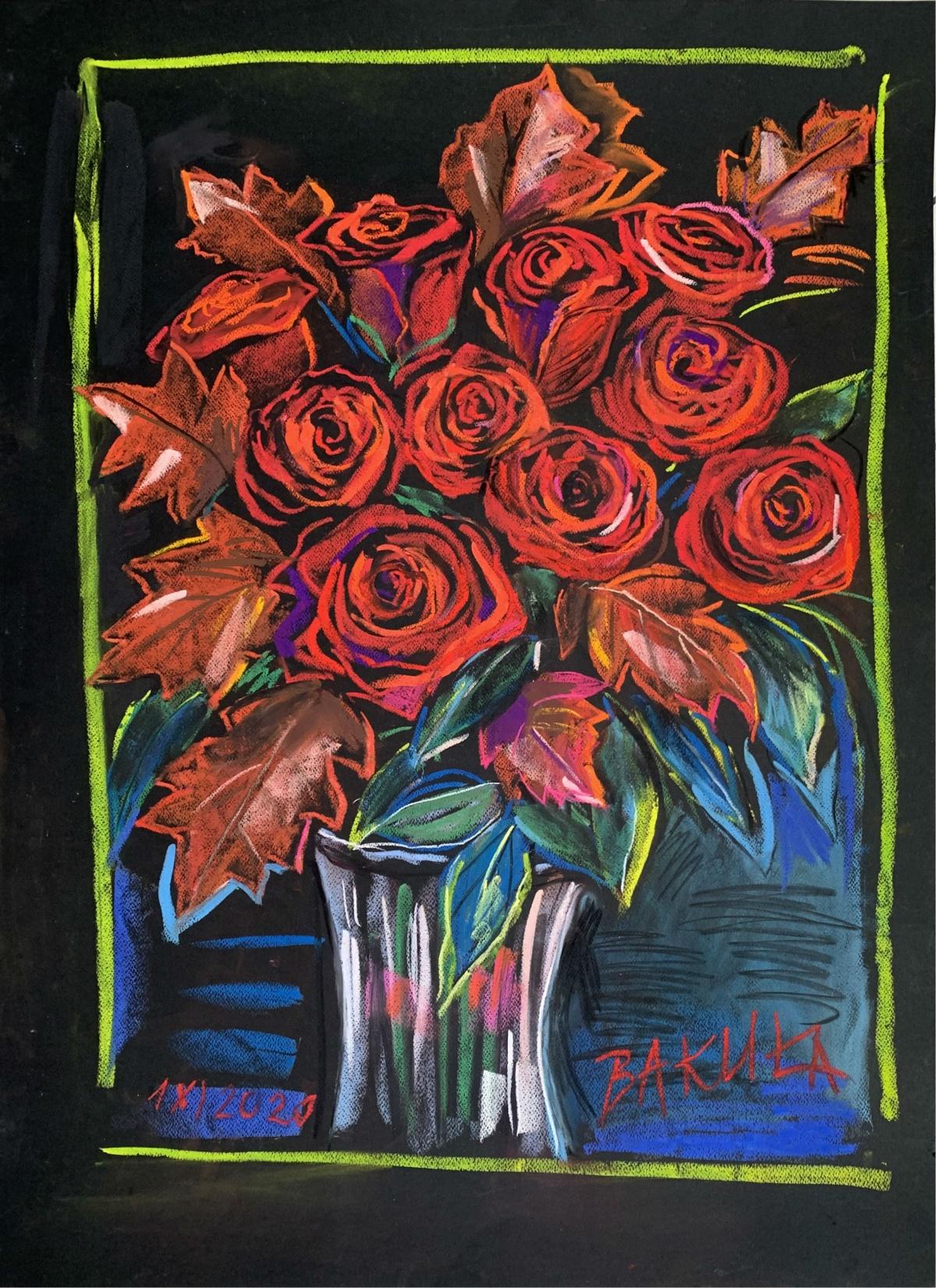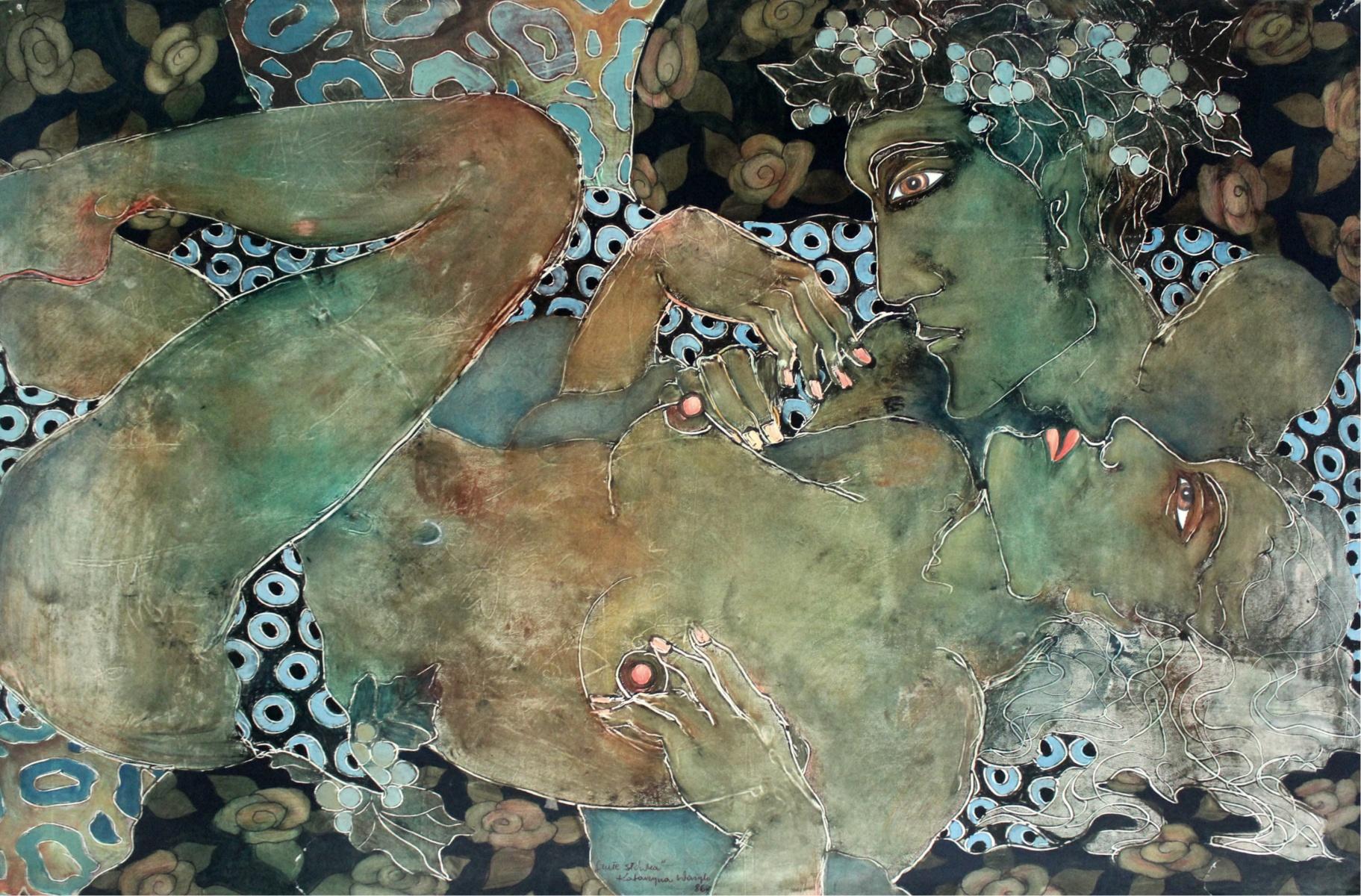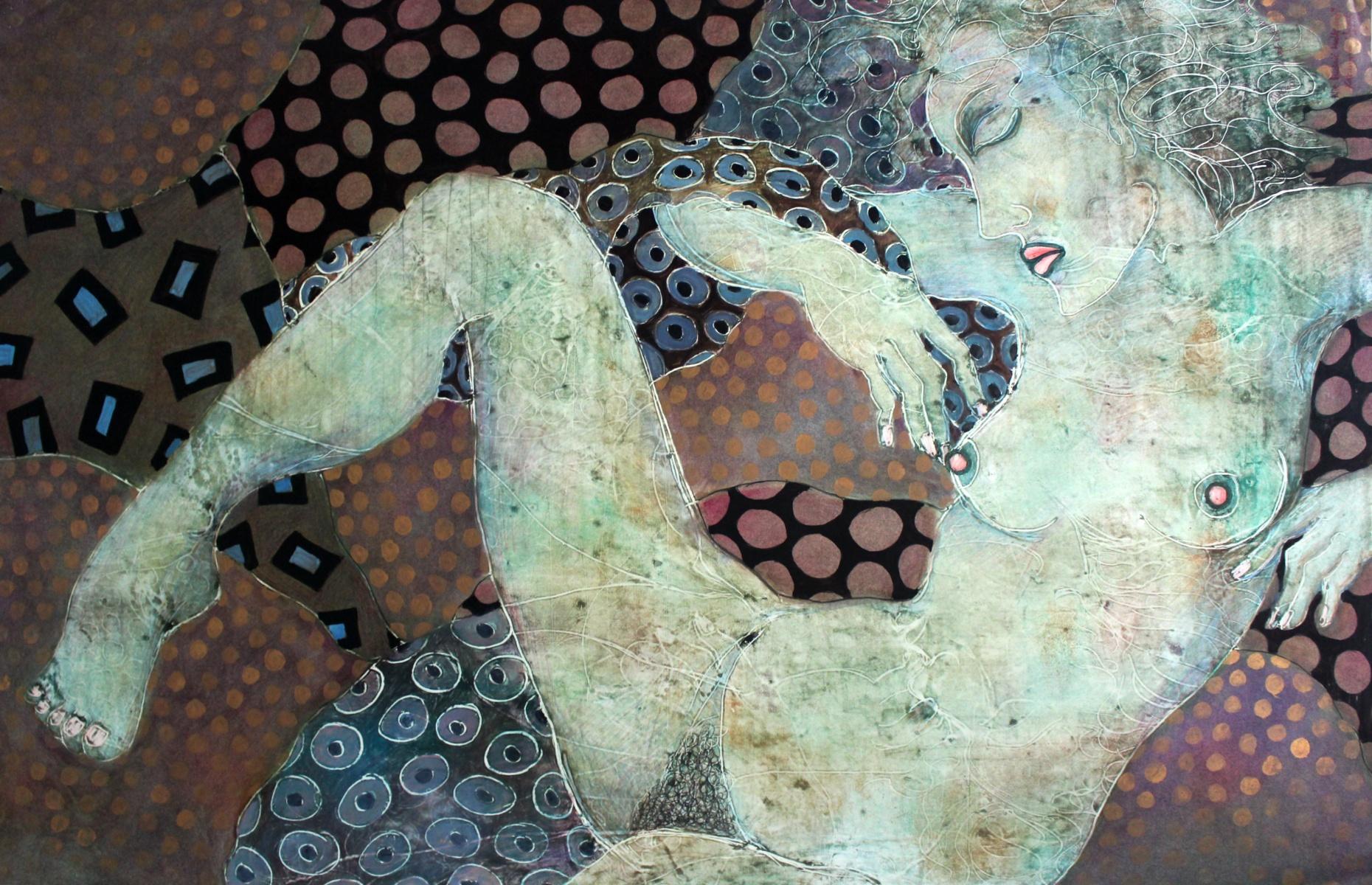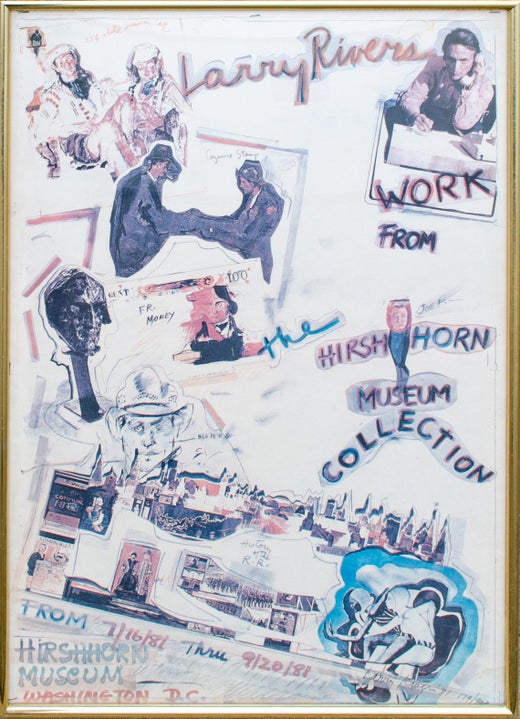Larry RiversUntitled (Joe and Patsy LoGuidice at the Casa Luna)1970-1975
1970-1975
About the Item
- Creator:Larry Rivers (1923 - 2002, American)
- Creation Year:1970-1975
- Dimensions:Height: 31.5 in (80.01 cm)Width: 24.5 in (62.23 cm)
- Medium:
- Movement & Style:
- Period:
- Condition:
- Gallery Location:Fairlawn, OH
- Reference Number:
Larry Rivers
Figurative artist Larry Rivers was born in the Bronx in 1923 to Ukrainian Jewish parents, and was named Yitzak Loiza Grossberg. Rivers belonged to the second generation of the New York School of painters, although unlike most of his contemporaries he stayed away from abstraction instead preferring narrative paintings. He began his artistic career playing the jazz saxophone, and when one night his group was introduced as "Larry Rivers and the Mudcats," he decided to keep the name.
After a brief period in the army during World War II, Rivers attended Juilliard School of Music for one year before returning to the jazz saxophone. After he met the painter Jane Freilicher, he decided to devote himself to painting. Rivers attended Hans Hofmann's school for nearly two years. In 1949, he had his first solo show at the Jane Street Gallery, an artist's co-op in the Village. Rivers received favorable reviews and was invited to join the Tibor de Nagy Gallery uptown.
Rivers continued to show annually at the Tibor de Nagy Gallery from 1952 to 1962. In 1963, he joined the Marlborough Gallery, where he stayed until his death. In 1955, The New York Museum of Modern Art acquired his painting Washington Crossing the Delaware, and in 1956 the Whitney Museum purchased Double Portrait of Berdie, two of his more famous paintings. He had periodic museum shows in Europe and the United States throughout his career.
Rivers had two sons, Joseph and Steven, by his first wife, Augusta. In 1961 he married Clarice Price and had two more children, Gwynne and Emma. In the 1970s he had another son with the painter Daria Deshuk.
The subjects of River's figurative paintings were family, history, politics, religion and sex. His work done in oils often included the use of stencils, cutouts, blank canvas and image reversals. He often painted family members including his mother in law, his sons and his ex-wife. Rivers favored historical subjects such as History of Matzah: The Story of the Jews (1984-85), History of the Russian Revolution (1965) and often painted parodies including his Washington Crossing the Delaware. He enjoyed controversial subjects and shocking the public. Lapman Loves It (1966) is a nine-foot electrified assemblage complete with strategically located light bulbs. French Vocabulary Lesson (1961-62) is a nude with body parts labeled in French.
Rivers was also a writer. In 1979 he published Drawings and Digressions with Carol Brightman. In 1992 he published What Did I Do? The Unauthorized Autobiography with Arnold Weinstein.
Find original Larry Rivers prints and paintings on 1stDibs.
(Biography provided by Lincoln Glenn)
- ShippingRetrieving quote...Ships From: Fairlawn, OH
- Return PolicyA return for this item may be initiated within 10 days of delivery.
- Woman on a PatioBy Karl Albert BuehrLocated in Fairlawn, OHWoman on a Patio Pastel on paper, c. 1915 Unsigned Provenance: Gift of the artist to his wife, Mary Hess Buehr By decent to the artist's niece, daughter of Will Hess David Saltzman Robert Henry Adams Fine Art Thomas French Fine Art Ronald C. Sloter, Columbus, Ohio Columbus College of Art and Design (de-accessed) Exhibited at Robert Henry Adams Fine Art, 1994, the first exhibition at the North Franklin Street Gallery. One of the early Chicago artists to adopt Impressionism, Karl Buehr became a figure and landscape painter. As a figure painter, his specialty became "gorgeously colored images of young women on porches overlooking brilliant summertime gardens." (Kennedy 98) His later work often showed a female figure with serious expression engaging the viewer with a direct stare. In his landscapes, he was noted for his strong coloration. In a December 1896 student exhibition at the Art Institute, a reviewer for the "Chicago Times Herald" described Buehr's landscapes as "blithe and joyous" with "country roads brilliant in sunlight . . . fields rich in summer verdure, under soft skies painted in a high, musical key." (Gerdts 68) Buehr was born as one of seven sons to a prosperous German family who immigrated to America and settled in Chicago in 1869. He was first exposed to his signature style of Impressionism in 1888 when he enrolled in night classes at the Art Institute while working in the shipping department of a lithographic firm near the Institute. He remained a student there until 1897 and was recognized in a "Chicago Times Herald" editorial of June 13, 1897 as one of the Institute's most outstanding pupils. The next year, his art career was temporarily put on hold when he briefly enlisted with the U.S. Army in the Spanish American War. In 1899, he resumed his art studies, this time with Frank Duveneck. He exhibited a painting at the Paris Salon of 1900. In 1905, thanks to a wealthy Chicago patron, Buehr and his family moved to France. They spent the following year in Taormina, Sicily, and spent time in Venice as well. In Paris, Buehr studied at the Academy Julian with Raphael Collin for two years. Then he went to England, enrolling in the London Art School but had returned to Paris by 1908. During this time, he began painting at Giverny, the home of Impressionist leader Claude Monet (1840-1926, and by 1912, Buehr was listing that village as his home address. One of his good friends and associates at Giverny was Frederick Frieseke. One of Buehr's paintings from that time, "News from Home", was exhibited in 1913 at the French Salon in Paris and at the annual exhibit of the Chicago Art Institute. It shows a woman in floral dress sitting on a porch with a background with potted flowers and lush greenery background. Of his painting done at Giverny, Buehr wrote in 1912 to William Macbeth of Macbeth Galleries in New York: "My figures painted in and around Giverny are costumed and in appropriate out door settings." (Gerdts 68) In 1914, he returned to the United States and took a teaching position in Chicago at the Art Institute, which he held for the remainder of his life. He was married to Mary Hess, a painter of miniatures and decorative works. In 1928-29, he was a guest artist at Stanford University. Courtesy, AskArt “Karl Albert Buehr (1866–1952) was a painter born in Germany. Buehr was born in Feuerbach - near Stuttgart. He was the son of Frederick Buehr and Henrietta Doh (Dohna?). He moved to Chicago with his parents and siblings in the 1880s. In Chicago, young Karl worked at various jobs until he was employed by a lithograph company near the Art Institute of Chicago. Introduced to art at work, Karl paid regular visits to the Art Institute, where he found part-time employment, enabling him to enroll in night classes. Later, working at the Institute as a night watchman, he had a unique opportunity to study the masters and actually posted sketchings that blended in favorably with student's work. Having studied under John H. Vanderpoel, Buehr graduated with honors, while his work aroused such admiration that he was offered a teaching post there, which he maintained for many years thereafter. He graduated from the Art Inst. of Chicago and served in the IL Cav in the Spanish–American War. Mary Hess became Karl's wife—she was a student of his and an accomplished artist in her own right. In 1922, he was elected into the National Academy of Design as an Associate member. Art Studies in Europe In 1904, Buehr received a bronze medal at the St. Louis Universal Exposition, then, in 1905, Buehr and his family moved to France, thanks to a wealthy Chicago patron, and they spent the following year in Taormina, Sicily, where the artist painted local subjects, executing both genre subjects and landscapes as well as time in Venice. Buehr spent at least some time in Paris, where he worked with Raphaël Collin at the Académie Julian. Giverny and American Impressionism Prior to this time, Buehr had developed a quasi-impressionistic style, but after 1909, when he began spending summers near Monet in Giverny, his work became decidedly characteristic of that plein-air style but he began focusing on female subjects posed out-of-doors. He remained for some time in Giverny, and here he became well-acquainted with other well known expatriate America impressionists such as Richard Miller, Theodore Earl Butler, Frederick Frieseke, and Lawton Parker. It seems likely that Buehr met Monet, since his own daughter Kathleen and Monet’s granddaughter, Lili Butler, were playmates, according to George Buehr, the painter’s son. His other daughter Lydia died before adulthood due to diabetes. He returned to Chicago at the onset of World War I and taught at The Art Inst for many years. One of his noted pupils at the Art Institute was Archibald Motley...Category
1910s Abstract Impressionist Figurative Drawings and Watercolors
MaterialsPastel
- Double sided crayon drawing in colors: Study for "The Shoe" (recto)By Théophile Alexandre SteinlenLocated in Fairlawn, OHDouble sided crayon drawing: Front: Study for "The Shoe" Reverse: Studies of Figures Blue crayon, red and black crayons Image size: 19.25 x 15.375 inches Frame size: 30 x 25 1/2 inches Signed with the estate stamp, Lugt 2312b, recto and verso Annotated on verso in blue pencil: “On Demande des petites femmes...Category
1890s Art Nouveau Figurative Drawings and Watercolors
MaterialsCrayon
- Eileen LakeBy Adolf Arthur DehnLocated in Fairlawn, OHEileen Lake Crayon on paper, early1930's Initialed in pencil lower right (see photo) Titled and annotated verso "Eileen Lake, early 1930s girlfriend" Note: Eileen Hall Lake was an American poet and Adolf Dehn's girlfriend in the early 1930s. Provenance: Estate of the artist By descent Adolf Dehn, American Watercolorist and Printmaker, 1895-1968 Adolf Dehn was an artist who achieved extraordinary artistic heights, but in a very particular artistic sphere—not so much in oil painting as in watercolor and lithography. Long recognized as a master by serious print collectors, he is gradually gaining recognition as a notable and influential figure in the overall history of American art. In the 19th century, with the invention of the rotary press, which made possible enormous print runs, and the development of the popular, mass-market magazines, newspaper and magazine illustration developed into an artistic realm of its own, often surprisingly divorced from the world of museums and art exhibitions, and today remains surprisingly overlooked by most art historians. Dehn in many regards was an outgrowth of this world, although in an unusual way, since as a young man he produced most of his illustrative work not for popular magazines, such as The Saturday Evening Post, but rather for radical journals, such as The Masses or The Liberator, or artistic “little magazines” such as The Dial. This background established the foundation of his outlook, and led later to his unique and distinctive contribution to American graphic art. If there’s a distinctive quality to his work, it was his skill in introducing unusual tonal and textural effects into his work, particularly in printmaking but also in watercolor. Jackson Pollock seems to have been one of many notable artists who were influenced by his techniques. Early Years, 1895-1922 For an artist largely remembered for scenes of Vienna and Paris, Adolf Dehn’s background was a surprising one. Born in Waterville, Minnesota, on November 22, 1895, Dehn was the descendent of farmers who had emigrated from Germany and homesteaded in the region, initially in a one-room log cabin with a dirt floor. Adolf’s father, Arthur Clark Dehn, was a hunter and trapper who took pride that he had no boss but himself, and who had little use for art. Indeed, during Adolf’s boyhood the walls of his bedroom and the space under his bed were filled with the pelts of mink, muskrats and skunks that his father had killed, skinned and stretched on drying boards. It was Adolf’s mother, Emilie Haas Dehn, a faithful member of the German Lutheran Evangelical Church, who encouraged his interest in art, which became apparent early in childhood. Both parents were ardent socialists, and supporters of Eugene Debs. In many ways Dehn’s later artistic achievement was clearly a reaction against the grinding rural poverty of his childhood. After graduating from high school in 1914 at the age of 19—an age not unusual in farming communities at the time, where school attendance was often irregular—Dehn attended the Minneapolis School of Art from 1914 to 1917, whose character followed strongly reflected that of its director, Munich-trained Robert Kohler, an artistic conservative but a social radical. There Dehn joined a group of students who went on to nationally significant careers, including Wanda Gag (later author of best-selling children’s books); John Flanagan (a sculptor notable for his use of direct carving) Harry Gottlieb (a notable social realist and member of the Woodstock Art Colony), Elizabeth Olds (a printmaker and administrator for the WPA), Arnold Blanch (landscape, still-life and figure painter, and member of the Woodstock group), Lucille Lunquist, later Lucille Blanch (also a gifted painter and founder of the Woodstock art colony), and Johan Egilrud (who stayed in Minneapolis and became a journalist and poet). Adolf became particularly close to Wanda Gag (1893-1946), with whom he established an intense but platonic relationship. Two years older than he, Gag was the daughter of a Bohemian artist and decorator, Anton Gag, who had died in 1908. After her husband died, Wanda’s mother, Lizzi Gag, became a helpless invalid, so Wanda was entrusted with the task of raising and financially supporting her six younger siblings. This endowed her with toughness and an independent streak, but nonetheless, when she met Dehn, Wanda was Victorian and conventional in her artistic taste and social values. Dehn was more socially radical, and introduced her to radical ideas about politics and free love, as well as to socialist publications such as The Masses and The Appeal to Reason. Never very interested in oil painting, in Minneapolis Dehn focused on caricature and illustration--often of a humorous or politically radical character. In 1917 both Dehn and Wanda won scholarships to attend the Art Students League, and consequently, in the fall of that year both moved to New York. Dehn’s art education, however, ended in the summer of 1918, shortly after the United States entered World War I, when he was drafted to serve in the U. S. Army. Unwilling to fight, he applied for status as a conscientious objector, but was first imprisoned, then segregated in semi-imprisonment with other Pacifists, until the war ended. The abuse he suffered at this time may well explain his later withdrawal from taking political stands or making art of an overtly political nature. After his release from the army, Dehn returned to New York where he fell under the spell of the radical cartoonist Boardman Robinson and produced his first lithographs. He also finally consummated his sexual relationship with Wanda Gag. The Years in Europe: 1922-1929 In September of 1921, however, he abruptly departed for Europe, arriving in Paris and then moving on to Vienna. There in the winter of 1922 he fell in love with a Russian dancer, Mura Zipperovitch, ending his seven-year relationship with Wanda Gag. He and Mura were married in 1926. It was also in Vienna that he produced his first notable artistic work. Influenced by European artists such as Jules Pascin and Georg Grosz, Dehn began producing drawings of people in cafes, streets, and parks, which while mostly executed in his studio, were based on spontaneous life studies and have an expressive, sometimes almost childishly wandering quality of line. The mixture of sophistication and naiveté in these drawings was new to American audiences, as was the raciness of their subject matter, which often featured pleasure-seekers, prostitutes or scenes of sexual dalliance, presented with a strong element of caricature. Some of these drawings contain an element of social criticism, reminiscent of that found in the work of George Grosz, although Dehn’s work tended to focus on humorous commentary rather than savagely attacking his subjects or making a partisan political statement. Many Americans, including some who had originally been supporters of Dehn such as Boardman Robinson, were shocked by these European drawings, although George Grocz (who became a friend of the artist in this period) admired them, and recognized that Dehn could also bring a new vision to America subject matter. As he told Dehn: “You will do things in America which haven’t been done, which need to be done, which only you can do—as far at least as I know America.” A key factor in Dehn’s artistic evolution at this time was his association with Scofield Thayer...Category
1930s American Realist Figurative Drawings and Watercolors
MaterialsOil Crayon
- Deco WomanBy William SommerLocated in Fairlawn, OHDeco Woman Crayon on paper, c. 1920 Signed in ink lower left: "Wm. Sommer" (see photo) Provenance: Estate of the artist Edwin Sommer (the artist’s son) Jose...Category
1910s Art Deco Drawings and Watercolor Paintings
MaterialsCrayon
- The Mouth of HoneyBy George Wesley BellowsLocated in Fairlawn, OHThe Mouth of Honey Lithographic crayon and mixed media on paper mounted to support paper Initialed by the artist "GB" bottom center on image. (see photo) Titled in pencil in bottom m...Category
1920s Ashcan School Drawings and Watercolor Paintings
MaterialsCrayon
- Getting Ready for the Revolution - Learning How to Ride in the SubwayBy Adolf Arthur DehnLocated in Fairlawn, OHSigned: Adolf Dehn (VED) lower right corner (signed by Virginia Dehn, the artist’s widow); Tilted along the upper edge of the recto in pencil by the artist Verso inscriptions: “VF 3168.D” in a circle, also annotated in red pencil “32” in a circle and “699 Provenance: Mary Ryan...Category
1930s Figurative Drawings and Watercolors
MaterialsOil Crayon
- Meeting - XXI Century, Contemporary Figurative Pastel DrawingBy Magdalena Rytel-SkorekLocated in Warsaw, PLMagdalena Rytel-Skorek (born in 1976) She studied at the Faculty of Graphic Design at the European Academy of Arts in Arts in Warsaw. She graduated in 2001 from the studio of prof. J...Category
Early 2000s Contemporary Animal Drawings and Watercolors
MaterialsPaper, Pastel
- Antivirus flowers - Figurative Pastel Drawing, Colorgul, Vibrant, Still lifeBy Hanna BakułaLocated in Warsaw, PLHANNA BAKUŁA (born in 1950) Polish painter, stage designer and writer. Bakuła graduated with honors from the Academy of Fine Arts in Warsaw, where she studied under such polish masters as J. Tarasin, E. Eibisch, A. Kobzdej. In 1981 she moved to New York and settled down on Manhattan. She painted, designed scenography and costumes for the avant-garde theatre "The Kitchen". These designs were praised by "The New York Times" as the best of the Off Broadway projects and won the first prize. She received a scholarship from the Guggenheim Foundation. In 1989 she came back to Poland. Since 1996 years Bakuła has organized Franz Schubert...Category
1980s Contemporary Figurative Drawings and Watercolors
MaterialsPaper, Pastel
- A dusk - XXI Century, Contemporary Pastel Drawing, LandscapeBy Maka CieleckaLocated in Warsaw, PLMaka Cielecka Graduated from the Warsaw Academy of Fine Arts. Worked in Canada and in the Netherlands as a graphic artist. In the mid-90s she began her extensive travels, including t...Category
21st Century and Contemporary Contemporary Figurative Drawings and Water...
MaterialsPastel, Cardboard
- Tender words - XX Century, Mixed Media Figurative Painting, Nude, CoupleBy Katarzyna WazykLocated in Warsaw, PLGabryela Wasowicz is a Polish painter born in 1947. She studied at the Academy of Fine Arts of Warsaw and then at the Gerrit Rietveld Akademie in Amsterdam. Once she graduated in 197...Category
1980s Contemporary Nude Drawings and Watercolors
MaterialsPaper, Pastel, Watercolor, Gouache
- Forest in Laski - XXI Century, Contemporary Pastel Drawing, LandscapeBy Maka CieleckaLocated in Warsaw, PLMaka Cielecka Graduated from the Warsaw Academy of Fine Arts. Worked in Canada and in the Netherlands as a graphic artist. In the mid-90s she began her extensive travels, including t...Category
21st Century and Contemporary Contemporary Figurative Drawings and Water...
MaterialsPastel, Cardboard
- Don't wake up the princess - XX Century, Mixed Media Figurative Painting, NudeBy Katarzyna WazykLocated in Warsaw, PLGabryela Wasowicz is a Polish painter born in 1947. She studied at the Academy of Fine Arts of Warsaw and then at the Gerrit Rietveld Akademie in Amsterdam. Once she graduated in 197...Category
1980s Contemporary Nude Drawings and Watercolors
MaterialsPaper, Pastel, Watercolor, Gouache






